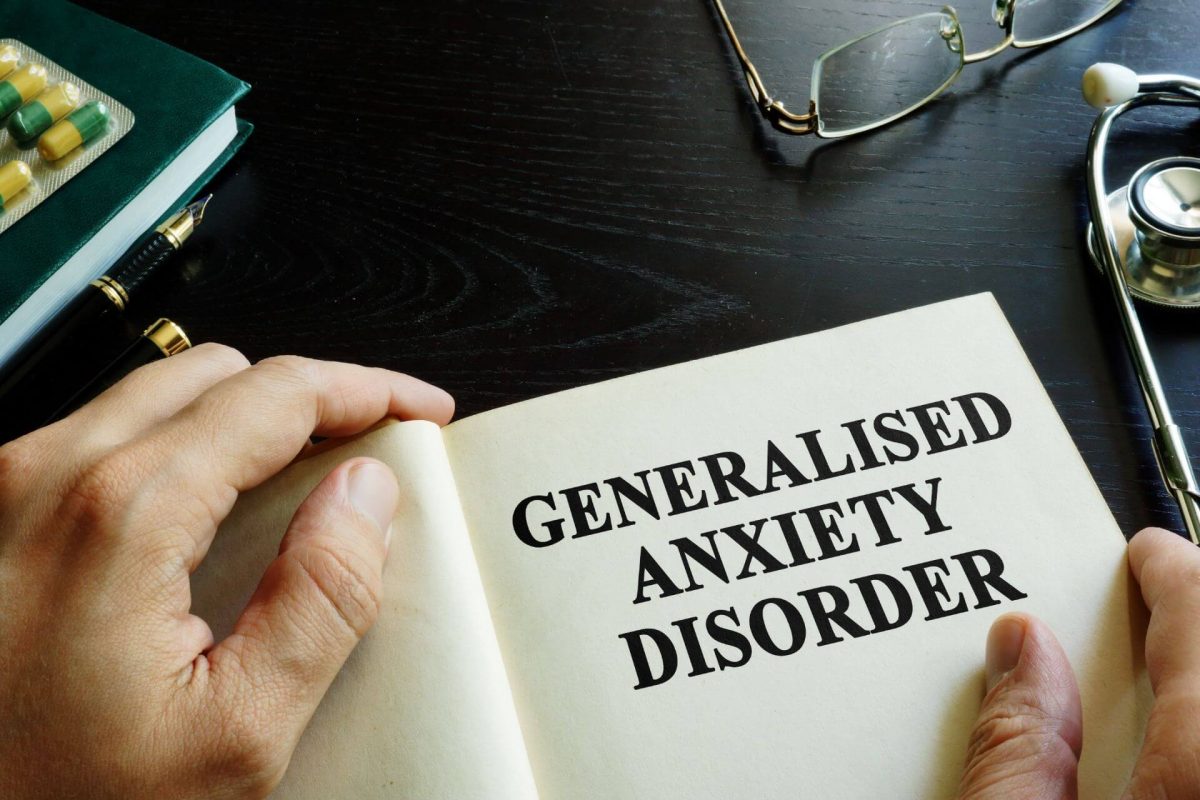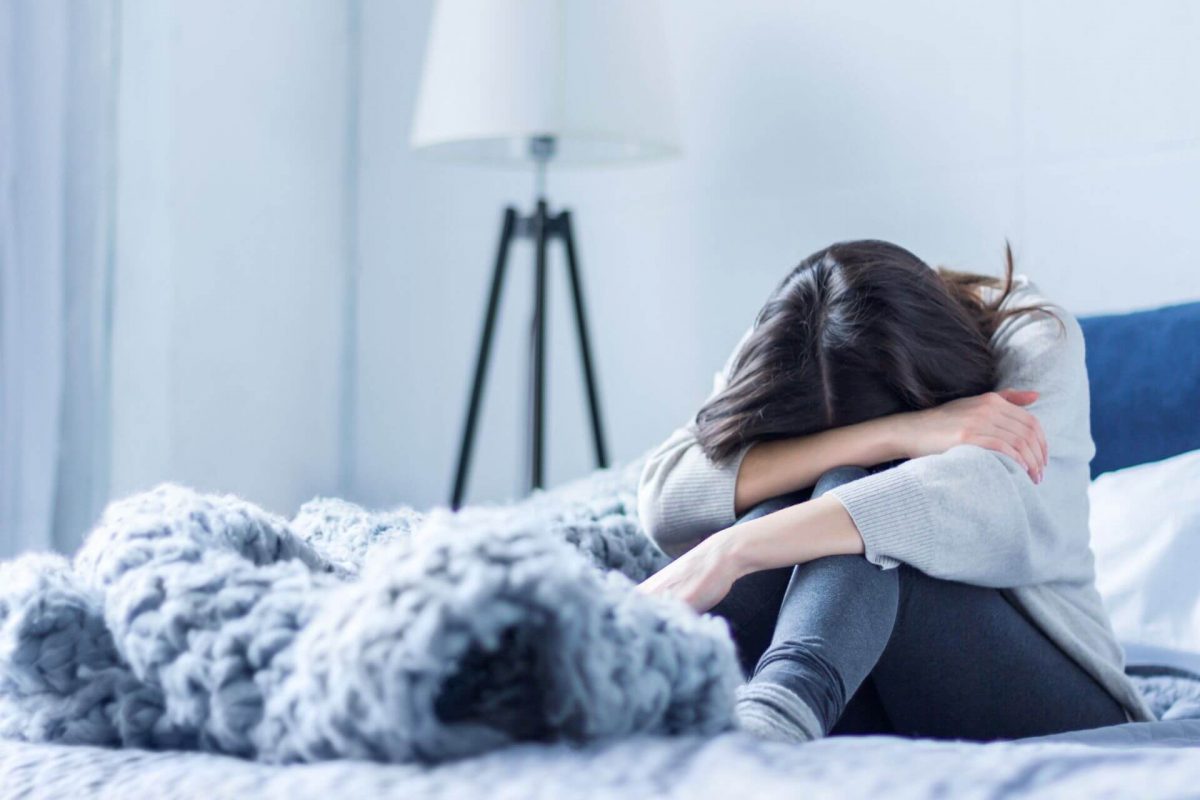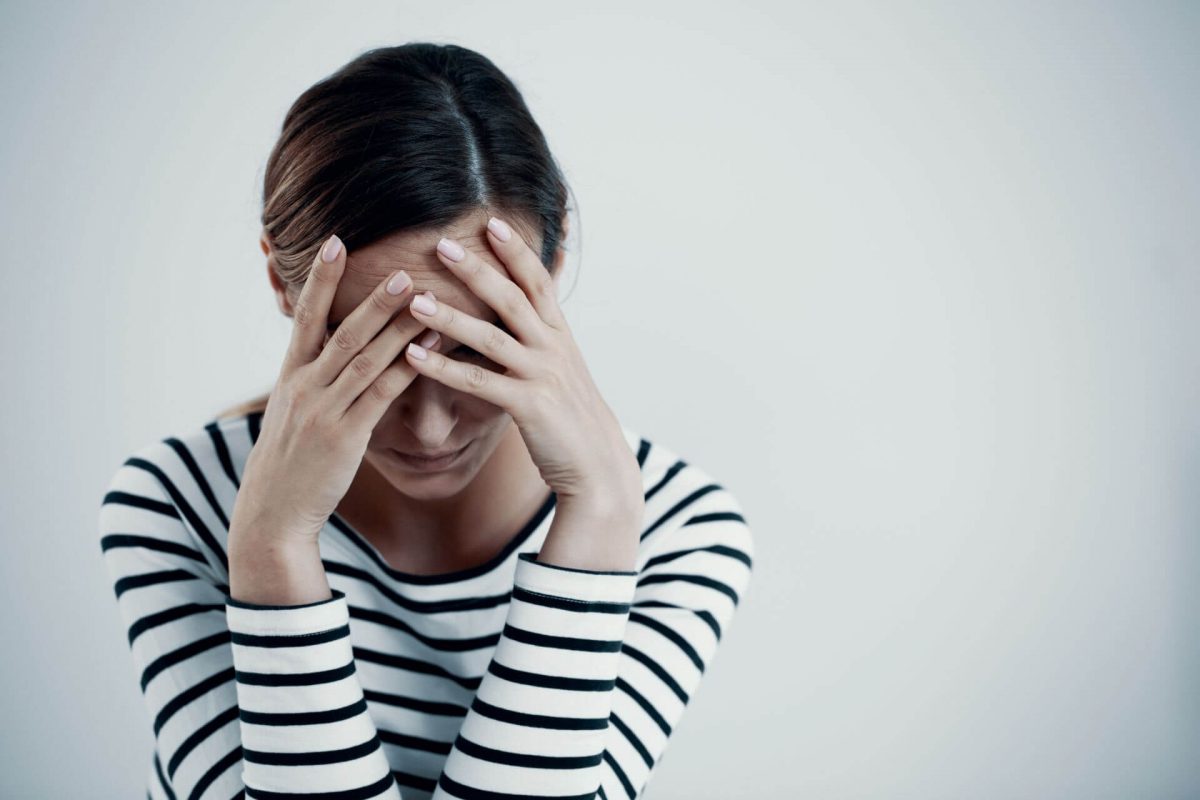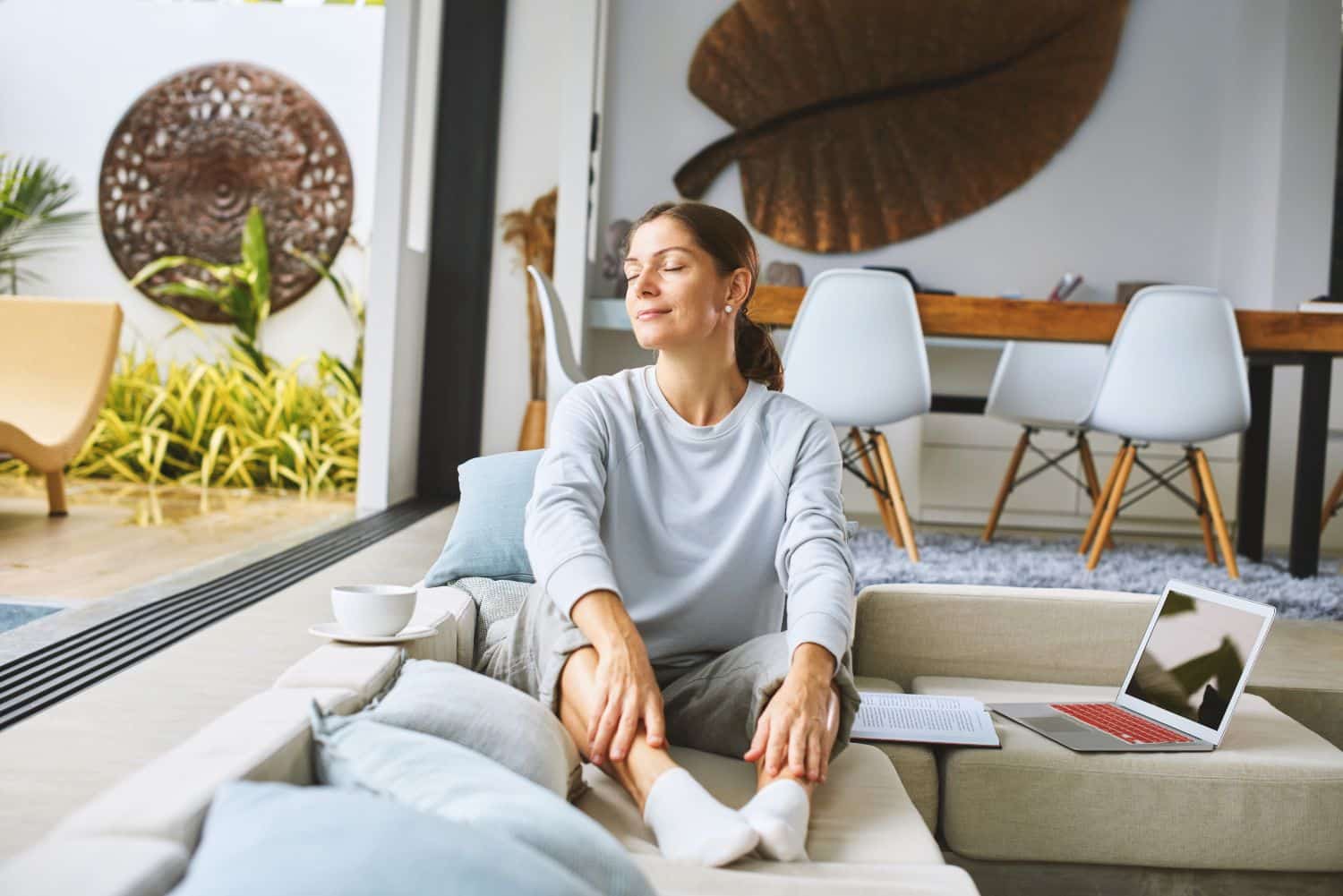What does anxiety feel like?
For some, it is a state of fear, unease or worry that makes your heart beat a little faster, your palms sweaty, or butterflies are flapping in your tummy.
For others, it feels like you are disconnected from yourself, there’s a dark cloud hanging over you, something is sitting heavily on your chest or stabbing you in the heart, or your mind is racing and you feel like your brain could explode at any minute.
It all depends on whether you are experiencing a natural response to an event like upcoming exams, starting a new job or money problems, or experiencing chronic symptoms associated with an anxiety disorder.
Of course, it’s perfectly natural to feel anxious. It’s a human response to stressful times in your life. However, it has progressed to a disorder if anxiety symptoms affect your physical and emotional wellbeing and disrupt home, work, school, relationships, and social activities
It is possible to manage an anxiety disorder with an integrated treatment Program that includes medication, psychotherapy, exercise, supplements and a healthy, balanced diet. The first step is to see a mental health professional and get a proper diagnosis. Chronic anxiety does not go away on its own, and you must seek help before it develops into something more severe and takes a toll on your life.
Common emotional signs of generalised anxiety
- feel uneasy, fearful or worried most of the time
- struggle to concentrate or your memory is poor
- constantly feel tired, even if you get enough sleep
- suffer from insomnia, lie away at night worrying
- find it difficult to relax, feel restless and agitated
- feel irritable and moody
- often feel close to tears or cry a lot
- feel insecure, need constant reassurance
- confidence and self-esteem is low
- don’t feel like yourself, feel disconnected
- avoid social activities, spend more time on your own
Common physical signs of generalised anxiety
- racing or irregular heartbeat
- heavy breathing, shallow breaths, hyperventilating
- sweaty palms, feel clammy
- sleep too much or too little
- headaches, feel like you have a tight band around your head
- chest pains, crushing feeling on your chest
- feel nauseous, off-colour for no reason
- dizziness, feeling faint, buzzing in your head
- have ‘butterflies’ in your tummy, strange sensation in your stomach
- unexplained illnesses, get sick often
- eat too little or overeat, comfort eat
- frequently need to urinate
5 major types of anxiety disorders
There are over ten anxiety disorders, but five are classified as major treatable disorders and are more common in the general population.
Generalised anxiety disorder (GAD)

Generalised anxiety disorder is a chronic condition characterised by severe anxiety brought on by debilitating tension, fear and excessive worrying. GAD may occur even if there is no specific reason or traumatic event that makes you anxious.
Usually, people experience anxiety for a reason, like problems with money, health, relationships, school or work. GAD can cause severe anxiety symptoms for no reason at all. Often, you can’t put it down to one thing that has triggered your symptoms.
Someone with GAD constantly worries about various issues, often things out of their control like climate change, natural disasters or political instability. Or it can be problems closer to home, like feeling you are worthless, useless or unloved. You cannot control your anxiety and struggle to be reassured that you have “nothing to worry about”.
GAD is difficult and unpleasant to live with, but it becomes a problem when it adversely affects your physical and mental health. Physical symptoms like headaches, chest pains, stomach aches, and muscle tension can affect how well you do at school or work and strain relationships with family and friends. Emotional symptoms can lead to chronic depression and suicidal thoughts.
Social anxiety disorder (social phobia)
Social anxiety disorder (SAD) is characterised by overwhelming anxiety related to ordinary social occasions. It’s natural to feel anxious starting a new job, speaking in public, going on a date or meeting up with friends at the Mall. The difference is social phobia causes one to feel highly anxious, terrified, self-conscious and out-of-your-mind stressed. Symptoms of social phobia are out of your control and out of proportion to the social event or activity.
Someone with SAD eventually resists or avoids socialising altogether out of fear of being judged or scrutinised by family, friends or peers. This fear can leave you feeling isolated, lonely and depressed. SAD can have a devastating effect on your daily life, relationships and ability to perform well at work or school. It can lead to substance use disorder, suicidal thoughts or actual suicide.
SAD is a chronic mental illness that needs to be treated before it’s too late. Social phobia does not go away on its own, but it can be managed through an integrated treatment Program that includes the right medication, talk therapy, mindfulness meditation and deep breathing exercises.
Obsessive-Compulsive Disorder (OCD)
Obsessive-Compulsive Disorder (OCD) is a chronic anxiety disorder where recurring, unwanted thoughts (obsessions) become repetitive behaviours (compulsions). Someone with OCD will distract their frantic, busy, anxious mind by carrying out rituals, such as obsessive hand-washing, touching points multiple times, checking and rechecking, counting or cleaning.
The rituals provide temporary relief and help to reduce feelings of fear, worry and unease. However, the anxiety always builds up, and you feel compelled to perform your rituals almost on a loop. OCD is partially a genetic disposition and partly learned behaviour.
The disorder is often more prevalent in older teens or young adults. The obsessive-compulsive rituals can last into late adulthood, but most people with OCD take medication to ease anxiety and learn to manage their behaviour.
Signs of OCD are:
Obsession with cleaning and contamination: fear of germs or diseases, frequently wash hands, scrub surfaces repeatedly
Obsession with symmetry and order: compelled to straighten or balance things, frequently reorganise and realign things, keep counting items, frequently touch things, believe something terrible will happen if they don’t carry out the ritual properly
Unwanted, intrusive thoughts: obsessed with thoughts of a sexual or violent nature, constantly question their sexual identity, feel guilty and ashamed of desires and thoughts, overzealous religious ideology, compelled to hide things, need constant reassurance they aren’t “bad”
Hoarding: won’t throw anything away, obsessive shopping and collecting items they don’t need, keep many of the same items, surround themselves with clutter to “protect themselves from harm”, compelled to count important items frequently
Panic disorder
Someone with a panic disorder experiences sudden, frightening feelings of panic, usually for no specific reason or when there is no danger. A panic attack is experienced as unexpected physical symptoms, including shallow breathing, hyperventilating, racing or irregular heartbeat, chest pain, stomach pain, disorientation, dizziness, blurred vision, shaking, sweating, nausea and vomiting. When panic attacks are severe, you believe you are going crazy or could die at that moment.
You also live in constant fear you will have an unexpected panic attack in public. The fear can lead to you avoiding social activities or public events, leaving you feeling isolated, lonely and depressed. Panic disorder can be mild to chronic, with some people suffering physical anxiety attacks daily or weekly.
Panic disorder may occur because you have a genetic predisposition to the condition, have been exposed early in life to trauma or abuse, are experiencing extreme stress or have survived a traumatic event like a robbery, hijacking or death of a loved one.
Post-Traumatic Stress Disorder (PTSD)
PTSD is a chronic anxiety disorder that develops after being exposed to life-threatening trauma or an alarming event where you felt in grave physical danger. Typically, events that lead to PTSD are military warfare, natural disasters, accidents, a home invasion, robbery or hijacking, physical and emotional abuse and battery, or a serious illness.
PTSD develops if you fail to recover physically and emotionally from the trauma. You might think you’re okay but something small can trigger extreme anxiety, which sets off frightening physical symptoms that feel like a panic attack. It could be a car backfiring that reminds you of gunshots, the sound of running water that reminds you of floodwaters that swept you away, or a loud shout that brings back memories of your partner abusing you.
Someone with PTSD may suffer from unexpected flashbacks or nightmares that wake them up shaking, sweating and calling for help. At that moment, you feel you are experiencing the trauma all over again.
PTSD symptoms can last a few months after the event or for many years. It is a treatable condition and can be successfully managed with medication and psychotherapy. The sooner you get help for PTSD, the better; otherwise, it can lead to chronic depression, isolation, loneliness, and suicidal thoughts.
How do doctors test for an anxiety disorder?

It’s not easy to diagnose an anxiety disorder because common symptoms overlap with other diseases. No specific gene causes an anxiety disorder, and no blood test will detect the condition. Sometimes it can take months or years to formally determine a diagnosis.
Medical examination
Avoid self-diagnosing an anxiety disorder. Instead, visit a mental healthcare professional who can make an accurate diagnosis.
The doctor will ask you about your physical and mental history and whether family members have struggled with a mental illness.
The next step is a medical examination to rule out any physical illness or injury, hormone imbalance or substance use disorder.
Your doctor will then carry out various diagnostic tests, which involve filling out self-assessment questionnaires. The diagnostic tests help to narrow down what type of anxiety disorder is present.
There are a few tried-and-trusted tests used to diagnose an anxiety disorder:
Beck Anxiety Inventory (BAI)
The Beck Anxiety Inventory determines the severity of anxiety. The patient answers 21 multiple-choice questions, rating their experience of symptoms in the past week. Symptoms range from nervousness, tingling, breathing difficulties and wobbly legs to fear of dying or losing control. A BAI score of 0-21 indicates low anxiety; a score of 22-35 indicates moderate to severe anxiety.
Zung Self-Rating Anxiety Scale
A 20-point questionnaire records your level of anxiety relative to various issues, responding on a scale from ‘a little of the time’ to ‘most of the time’. The Zung test covers anxiety symptoms such as shaking, rapid heartbeat, nervousness, nightmares, dizziness or fainting, the need to urinate frequently, etc.
Yale-Brown Obsessive-Compulsive Scale (YBOCS)
The YBOCS test is used to diagnose the obsessive-compulsive disorder. Working with a psychologist, you pick three symptoms on a checklist that you find most disturbing and rate the severity of your symptoms. Your doctor grades the severity of your OCD from subclinical or mild to moderate, severe or extreme.
Hamilton Anxiety Scale (HAM-A)
The Hamilton test is widely used to diagnose different anxiety disorders. Patients answer 14 questions that rate their mood, fear and tension, and physical and emotional wellbeing.
Each question is scored on a scale of 0 (not present) to 4 (severe). The total score is 56 points; less than 17 points is mild severity, 18-24 points is moderate severity, and 25+ is moderate to severe anxiety.
Generalised Anxiety Disorder Scale (GAD Scale)
The GAD Scale is used to determine if generalised anxiety disorder (GAD) is present. Patients fill out a 7-point questionnaire that asks how often they have experienced feelings such as fear, nervousness, irritability etc. in the past two weeks. The patient uses a 4-point scale, from ‘not at all’ to ‘nearly every day’.
Social Phobia Inventory (SPIN)
The SPIN test measures your level of social phobia. You fill out a 17-point questionnaire using a four-point scale and record your level of anxiety in different social situations. A SPIN score of 21-30 shows mild social phobia is present, 31-40 points is moderate, 41-50 is severe, and 50 plus indicates social phobia is very intense.
Penn State Worry Questionaire
The Penn State Worry questionnaire measures levels of excessive, generalised and uncontrollable worry among patients. The questionnaire separates other anxiety disorders from a generalised anxiety disorder, where worry is a dominant characteristic of GAD. Patients complete a 16-point questionnaire using a Likert rating from 1 (not at all typical of me) to 5 (very typical of me).
How are anxiety disorders treated?

Anti-depressants
The first line of defence for anxiety disorders is selective serotonin reuptake inhibitors (SSRIs) or serotonin-norepinephrine reuptake inhibitors (SNRIs). In other words, anti-depressants. It can take two to six weeks for anti-depressants to start reducing symptoms of generalised anxiety, and it’s recommended you stay on the course for a minimum of six months.
Generally, anti-depressants are not habit-forming (addictive). Still, you can develop a dependence on them, meaning you will experience withdrawal symptoms when you stop or reduce the amount you use.
Benzodiazepines (benzos)
Benzodiazepines are drugs prescribed for instant relief from severe symptoms of anxiety. The most common benzos taken for anxiety disorders are Xanax, Klonopin, Valium, Ativan and Librium.
Benzos are sedation drugs that help you feel calm and relaxed. They work by speeding up the activity of a brain chemical called GABA, responsible for blocking nerve signals and reducing how “excitable” neurons get when chemical messages pass through the cells. In layman’s terms, the GABA effect calms you down.
The problem with benzos is they are habit-forming, and you can become addicted to them. Benzos are extremely difficult to quit once you develop a tolerance for them. You might end up with a bigger problem than what you started with if you abuse benzos and develop a substance use disorder.
Psychotherapy (talk therapy)
Psychotherapy should always go hand-in-hand with drugs used for anxiety to ensure you deal with your whole physical and emotional wellbeing. One of the most popular techniques used to treat various anxiety disorders is cognitive behavioural therapy. CBT provides the tools you need to avoid anxiety-triggering moments and helps you cope with anxiety symptoms.
We’re here to help.
White River Manor offers a comprehensive treatment Program for substance use disorder and dual diagnosis, where a mental health disorder co-occurs with addiction. White River Manor also runs a wellness Program to help people recover from the physical and emotional symptoms of stress, depression and anxiety.
Contact us today if you’d like a confidential and free chat with one of our highly-trained professionals at White River Manor in South Africa.







